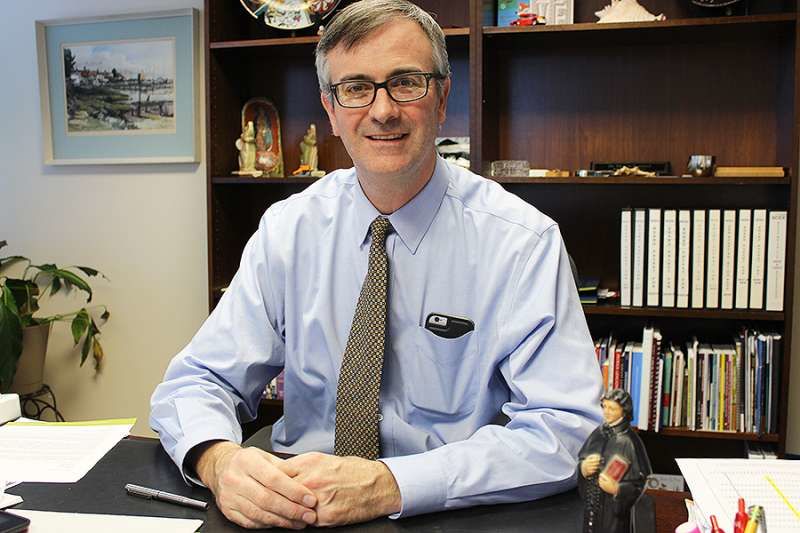Dr. Tom Burnford, president and CEO of the National Catholic Educational Association, spoke to CNA’s Jonah McKeown during Catholic Schools Week 2018 about his Catholic education and the evangelizing mission of Catholic schools in the United States.
How did your own Catholic education lead you to work in this field?
I was blessed to attend Catholic primary school in England, where I grew up: St. Joseph's in Storrington, in Sussex. And then I also went to Catholic high school: Ampleforth College in Yorkshire. My experience was a rigorous academic curriculum, and a study of the Catholic faith with a particular focus on scripture, and also living at the high school, a boarding school, in a community permeated by the gospel spirit. For me, the witness of the teachers, some of whom were Benedictine monks, others were lay people...they witnessed a Catholic faith that made me believe what they said when they talked about their Catholicism and their faith. Secondly, there were rigorous academic expectations, which led me to work hard and grow. And now I love Catholic schools because they integrate faith and knowledge in the life of the student and the adult.
How has the shift toward more lay teachers, rather than teachers who are members of a religious order, changed Catholic education in the U.S.?
Catholic schools in the United States were founded on the work of religious brothers and sisters, and today the staffing of schools, as we know, is predominantly lay teachers, lay faculty, and lay principals. However, it is the same faith that moves teachers today to teach in a Catholic school, and to do this work of integrating knowledge in the life of the student. What can be difficult is that in the past, the sisters were in a religious community setting 24 hours a day, focused on the school. And therefore we seek new and fresh formation opportunities for teachers, particularly as the society around us changes and becomes less faith-filled. So many diocese are doing great work in faith-formation programs, many colleges and universities do great work in helping to form teachers and leaders who can do this critical work of integrating faith and knowledge in education.
Along with an increasingly secular society, what are some of the other challenges that Catholic schools are facing today?
TB: Catholic schools face challenges today in terms of the financing ... in the United States, the parental choice legislation is growing, and yet there is still huge need for fixing the injustice of the public school monopoly on tax funds that come from everybody. I think another challenge is helping the general population understand that Catholic schools don't just teach religion. They form the whole person, with excellent academics and with values that come from and are rooted in a deep Catholic faith. Our research shows that the vast majority of all parents want a values-based education for their children...that's what Catholic schools do, and so much more. They form young people with solid values as well as providing a great academic education.
It sounds as though you're really trying to make evangelization an integral part of this. Would you say the whole mission of Catholic schools is one of evangelization?
Absolutely. Catholic schools are instruments of the new evangelization. They are evangelistic communities of faith, that serve as a witness not only to the parents who come to the school, but to the entire parish geography and surrounding neighborhoods.
For someone reading who may not be aware of how Catholic schools benefit the United States, what would you say to that person?
Catholic schools form great citizens. For example, Catholic school graduates vote more than the general population. Our academics are, overall, better than public education. We have higher graduation rates, by far, and higher college success rates. The graduates of Catholic schools are contributing citizens who are formed for success in life and contribution and service to society.
In what ways are the NCEA and Catholic schools in general reaching out to the changing demographics of the Catholic Church in the United States?
A critical opportunity is to collaborate within the Hispanic and Latino community to fully welcome Hispanic and Latino Catholics to Catholic schools, because this is the future of the Church. So, the NCEA is working hard to reach out to Latino organizations around the country to ensure that Catholic schools are available and accessible to the greatest extent possible to all Catholics...particularly to minority students in urban areas. This week we just completed the Many Gifts, One Nation program, and through social media invited all alumni of Catholic schools to contribute, in a 24-hour period, to Catholic schools. We raised $750,000 in 24 hours, our first year. This is a significant initiative of NCEA to help, in a small way, with funding issues at Catholic schools.
Is there anything you'd like to say about this year’s Catholic Schools Week?
I started Catholic Schools Week on Monday morning at the Shrine of St. Elizabeth Ann Seton in Emmitsburg, Maryland, and I was blessed to be able to pray for Catholic school educators and families in the room where Mother Ann Seton died. This was a great blessing to me, and how appropriate to start this celebration of Catholic schools nationally at the place where, in one sense, it all began with Elizabeth Ann Seton, who was so influential in founding this gift of Catholic schools in the United States.
Are you hopeful for the future of Catholic schools in the U.S.?
Absolutely. Catholic schools have a bright future in the U.S. We have challenges, and we have great successes. These schools work, Catholic schools work, in the formation of the whole person, and they're such a gift to the country because of the quality of graduates, who then contribute to society and to the Church.
Interested in more? Subscribe to Angelus News to get daily articles sent to your inbox.

